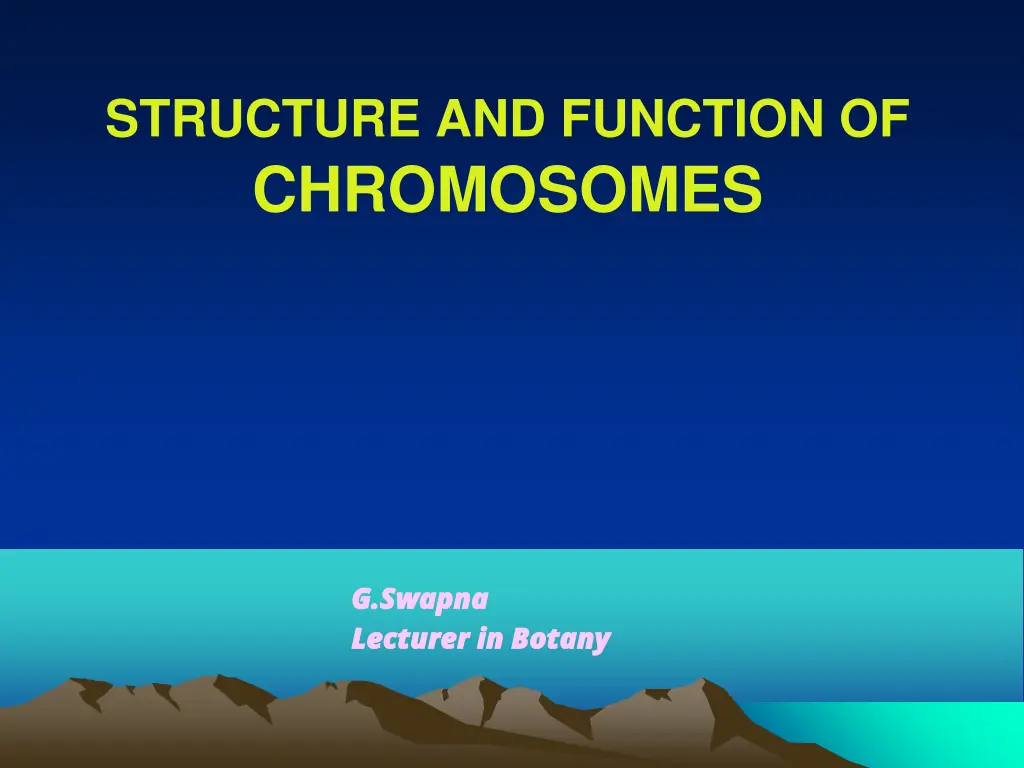
Understanding Chromosomes: Structure, Function, and Types
Explore the fascinating world of chromosomes with this detailed guide covering their structure, function, number, physical characteristics, types, and chemical composition. Discover the significance of chromosomes in inheritance and genetic information transfer.
Download Presentation

Please find below an Image/Link to download the presentation.
The content on the website is provided AS IS for your information and personal use only. It may not be sold, licensed, or shared on other websites without obtaining consent from the author. If you encounter any issues during the download, it is possible that the publisher has removed the file from their server.
You are allowed to download the files provided on this website for personal or commercial use, subject to the condition that they are used lawfully. All files are the property of their respective owners.
The content on the website is provided AS IS for your information and personal use only. It may not be sold, licensed, or shared on other websites without obtaining consent from the author.
E N D
Presentation Transcript
STRUCTURE AND FUNCTION OF CHROMOSOMES G.Swapna G.Swapna Lecturer in Botany Lecturer in Botany
DEFINITION OF CHROMOSOME It is a combination of two words, i.e., Chroma -means colour and Somes -means body . So the coloured thread like bodies present in the nucleoplasm of the living cells, which helps in the inheritance (transmission) of characters in form of Genes from generation to generation are known as CHROMOSOMES.
NUMBER OF CHROMOSOMES The number of chromosomes per organism is always a definite number, Which is said as Diploid (2n) no., but gametes, sperms, ova etc. carry Haploid (n) number. Some examples are given below. Name of the Diploid No. Name of the Diploid No. organism (2n) organism (2n) Human beings ---- 46 Onions ----- 16 Cat ---- 38 Corn ----- 20
PHYSICAL STRUCTURE Size varies from 1 to 30 micron in length and diameter from 0.2 to 2 micron. CENTROMERE:- The non-stainable part of the chromosome making a primary constriction. CHROMATIDS:- Two chromatids join at the centromere to form a chromosome. CHROMONEMA:- In each chromatid, there are two longitudinal chromonemata coiled with each other. CHROMOMERES:- In each chromonemata, there are bead like chromomeres present through out the coil. GENES:- Each chromomeres contains genes, the unit of inheritance of character. SATELLITE:- In some chromosomes a round and elongated satellite is present. CONSTRICTION:- Presence of centromere shows the primary constriction. But in some cases there is an additional Secondary Constriction. SURFACE VIEW
TYPES OF CHROMOSOMES 1. TELOCENTRIC:- The centromere is CENTROMERE present at the end of the chromosomes. LONG ARM SHORT ARM CENTROMERE 2. ACROCENTRIC:-The centromere is almost terminal. It has one large and another very small arm. LONG ARM
TYPES OF CHROMOSOMES (CONTINUED) 3. SUB-METACENTRIC:- Here the centromere is not at the middle chromosomes. So the arms are unequal and it is L-Shaped in appearance. SHORT ARM position of the CENTROMER E LONG ARM TWO EQUAL ARMS 4. METECENTRIC:- The centromere is at the middle position. So the arms are equal and it is V-Shaped in appearance. CENTROMER E
CHEMICAL STRUCTURE Chemically the chromosomes are made of proteins and nucleic acids. PROTEINS of acidic proteins. It is mainly Protamines, Histones and smaller amount NUCLEIC ACIDS are nothing but the segments of DNA. It is de-oxy ribose Nucleic Acids (DNA). Genes NB:- For brief notes about DNA structure, Open the Hyperlink at Right End. CLICK HYPERLINK
FUNCTION OF CHROMOSOMES FUNCTION OF CHROMOSOMES [I]- duplication. strands unwind. As unwinding starts, each template of DNA forms its complementary strand in double- helix nature. The conversion of the old DNA molecule into two new duplicating the chromosomes. The chromosomes During duplication process the DNA are capable of self- molecules, helps in
SELF DUPLICATION OF DNA MOLECULE (IT HELPS IN THE DUPLICATION OFCHROMOSOMES ) Two separate DNA molecules formed having an old and a new strand Single DNA molecule in double helical structure Mother templates unwind and new complementary strands originate Unwinding continues along with new template formation
Function of chromosomes (continued) [II]- They help in expression of different characters in an organism by synthesizing proteins in cells. A definite protein is accumulated to produce a definite character.
Function of chromosomes (continued) [III]- As carrier of genes they transmit characters from generation to generation , i.e. parents to offspring. [IV]- The chromosomes control the physiological and biochemical processes in the body of the organism.
